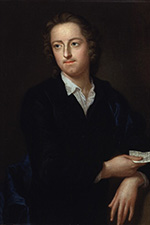Thomas Gray Manuscripts
When I expressed my astonishment at the extent of his reading he said, ‘Why should you be surprised, for I do nothing else.'" Norton Nicholls, Reminiscences of Thomas Gray, November 1805

Thomas Gray (1716-1771) was a poet and scholar. He spent much of his life in the University of Cambridge, first at Peterhouse then at Pembroke College, although he also spent significant periods living in London and travelling the British Isles, and he accompanied his friend Horace Walpole (1717-1797) on a Grand Tour of Europe between 1739 and 1741. Throughout the 250 years that have passed since Gray’s death, he has primarily been celebrated as a poet, especially for his Elegy Written in a Country Church Yard (1751). While he lived, however, he was equally renowned for his scholarship: his friend William Johnson Temple speculated that he was ‘the most learned man in Europe’. Although he did not publish any of his research, he had a significant influence on intellectual as well as literary life in the mid-eighteenth century, and like many scholars of the period he shared his learning as well as his verse through correspondence and manuscript circulation among coterie networks. Gray was a polymath, and his research traversed British, European, and global fields of knowledge, ancient and modern, including literature, history, geography, philosophy, law, religion, politics, music, visual art, natural history, and architecture, often in the course of what felt to him like single, unified enquiries. His characteristic method was to make preliminary notes on loose leaves, in smaller notebooks, and in the margins of his books, then digest and present his work more formally in his three-volume folio Commonplace Book.
This collection presents digital images of Gray’s manuscripts held in the University of Cambridge and its Colleges, with editorial and bibliographical metadata including description, collation, foliation, and content indexing prepared by the Editor, Ruth Abbott, and Associate Editor, Ephraim Levinson. Its contents make it especially significant for understanding Gray’s research, note-taking, and record-keeping: it includes his three-volume Commonplace Book and his pocket books for 1755 and 1760 alongside rougher notes on loose leaves. The collection also contains several of Gray’s compositions in Latin, illuminating his education, and unique versions of his poems in Latin and English: the Commonplace Book versions of his poems are here made more accessible than ever before, and his second-published poem, ‘Luna est habitabilis’, can be seen in its original form for the first time. The research and imaging have been generously funded by the Cambridge English Faculty, Pembroke College, and the University of Cambridge, enabling unprecedented access to Gray’s scholarship, new understanding of its range and methods, and a fascinating case study in eighteenth-century intellectual life.
Ruth Abbott
University of Cambridge
Image © National Portrait Gallery, London. Thomas Gray by John Giles Eccardt. Oil on canvas, 1747-1748.

